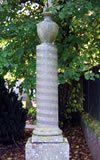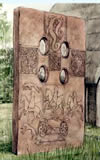St Palladius's Chapel Fordoun Parish Kirkyard, Auchenblae
 St Palladius
St Palladius
Mystery enshrouds the life of St. Palladius, the patron saint of this parish and the earliest Christian missionary in northern Scotland. He is believed to have been ordained by Pope Celestine in 430 AD and to have preached in Ireland before coming to the Mearns. The date and manner of his death are uncertain but it is written that he “was crowned with martyrdom” a few years after his arrival here. His relics were preserved within the chapel which he built and in succeeding churches. His chapel, recognised as the Mother Church of the Mearns, stood on this knoll high above the Luther Water.
St Palladius’s Chapel
St Palladius’s Chapel probably stands on the site of the cell built by the saint in the 5th century. The oldest part of the structure dates from 1244, when a new church here was dedicated by the Bishop of St Andrews. The medieval church was restored in the first half of the 16th century, the piscina in the east wall and the aumbry in the north wall dating from this time. It is believed that the south wall was largely rebuilt, and three arched windows inserted during the 17th century. The chapel was restored again in 1788. When the roof collapsed in 1828, the chapel was abandoned and the new kirk built alongside.
Within the ruined chapel are stone steps which lead to the crypt below. It is possible this is where the sacred relics of St. Palladius were preserved. Pilgrims came from far and wide to venerate the relics. Kenneth III is said to have been on such a pilgrimage to Fordoun when he died in 994. When Archbishop Shevez of St. Andrews came on pilgrimage in the early 16th century, he restored the chapel and donated a new silver shrine for the bones.
The remains of St Palladius’s Chapel have been consolidated as part of Aberdeenshire’s Historic Kirkyards project in 2006.
Fordoun Stone
 When the pulpit of St Palladius’s Chapel was being dismantled in 1787, a large sculptured slab was discovered below it. This stone, which may have been hidden there during the Reformation, is two metres tall and pierced by four circular holes in the upper half. One side is elaborately carved with a Latin cross and a hunting scene showing armed horsemen and a dog. The Pictish symbols of double disc and Z rod are also clearly engraved. Around the edge the letters “pidarnoin” are roughly incised in early Roman script. This may mean “Peace be with Idarnoin”, he was a 7th century Pictish bishop. The stone is now in the vestibule of the parish kirk.
When the pulpit of St Palladius’s Chapel was being dismantled in 1787, a large sculptured slab was discovered below it. This stone, which may have been hidden there during the Reformation, is two metres tall and pierced by four circular holes in the upper half. One side is elaborately carved with a Latin cross and a hunting scene showing armed horsemen and a dog. The Pictish symbols of double disc and Z rod are also clearly engraved. Around the edge the letters “pidarnoin” are roughly incised in early Roman script. This may mean “Peace be with Idarnoin”, he was a 7th century Pictish bishop. The stone is now in the vestibule of the parish kirk.
Fordoun Kirkyard
The oldest tombstones in this extensive kirkyard are found in and around St Palladius’s Chapel and to the south and east of the present church. Several stones are embellished with winged souls, skulls, bones and hourglasses. Many inscriptions list the occupation of the deceased. As would be expected in the heart of this agricultural district, tenant farmers and crofters are in the majority, but here also lie the innkeeper, bootmaker, flax spinner, bookseller, gamekeeper, minister, merchant, wright, coal merchant, blacksmith, fisherman and banker. The farmer’s coulter, the miller’s rind and the wright’s square are engraved on the appropriate stones. Above the memorial to shepherd, William Christison, is a hand with finger pointing heavenward and the word “HOME”.
Further information can be found in the leaflet St Palladius's Chapel (PDF 352KB) produced by Aberdeenshire Council.
Information regarding the survey undertaken in 1998 on St Palladius's Chapel can also be downloaded - St Palladius's Chapel Survey Findings (PDF 85KB).
